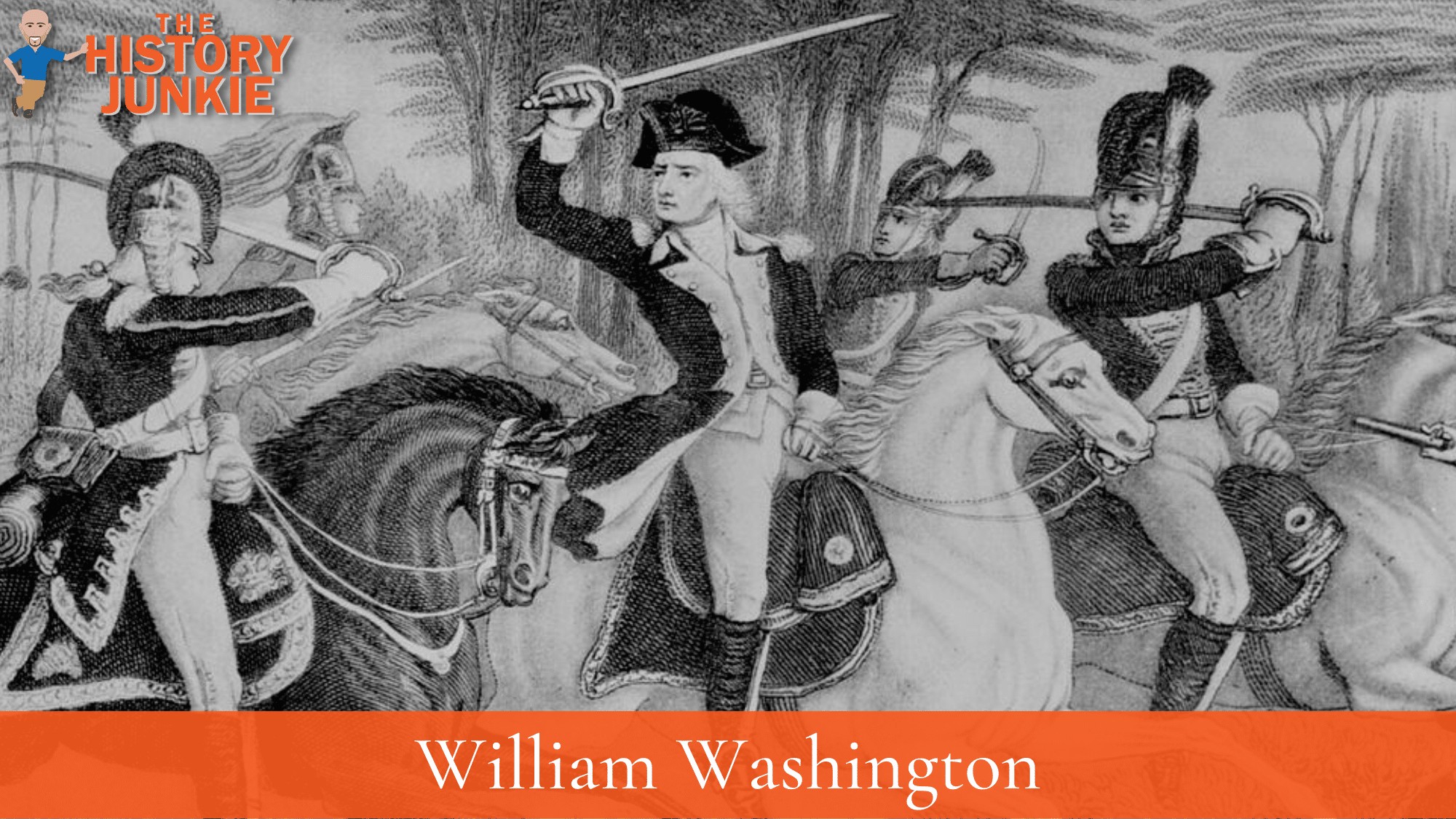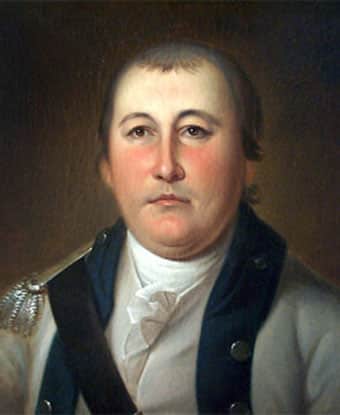William Washington was a cavalry officer of the Continental Army during the American Revolution. He fought in many significant battles, such as the Battle of Trenton and the Battle of Cowpens. He held the final rank of Brigadier General in the newly created United States.

He was a distant cousin of George Washington and fought under him during the 1776 campaign.
Early Years
William Washington was born in Stafford County, Virginia, and was the second son of Bailey Washington and Catherine Storke.
William was raised with a Southern planter upbringing, which instilled in him the values of a gentleman. He was tutored by Reverend Mr. Stuart, a clergyman from Virginia. Under his tutoring, he learned the Greek language and theology with aspirations of a life in ministry.
However, war broke out between the colonies and Great Britain, which put his clergy plans on hold. He and his brother wanted to enlist in the Continental Army. However, one had to stay behind and manage the family plantations. The brothers drew straws, and William won.
Genealogy and Connection to George Washington

Many say that William Washington was a second cousin to George Washington. However, that is not true. The two were much more distant than a second cousin.
William Washington and George Washington's common ancestor was John Washington.
John Washington was the great-grandfather of George Washington and the great-great-grandfather of William Washington.
Here is the connection.
Lawrence Washington -> Augustine Washington -> George Washington
John Washington -> Henry Washington -> Bailey Washington -> William Washington
American Revolution
William Washington was elected a captain of Stafford County Minutemen on September 12, 1775, and became part of the 3rd Virginia Regiment, Continental Line, on February 25, 1776, commanding its 7th Company.
His second-in-command was future president James Monroe.
Their first action was at the Battle of Harlem Heights during the disastrous New York Campaign. William was wounded during the battle.
He saw action again at the Battle of Trenton under the command of Nathanael Greene. He, along with James Monroe, led a scouting party prior to the battle and then proceeded to lead a successful assault into the town. His company drove in Hessian pickets and seized two cannons on King Street, capturing their crews.
Washington was again wounded in both hands. His friend James Monroe was also wounded in the shoulder. The two received thanks from commander-in-chief George Washington for their action.
While recuperating from his wounds, he was promoted to the rank of major and assigned to the newly created 4th Continental Light Dragoons. In the fall of 1778, he was reassigned to the 3rd Continental Light Dragoons.
The 3rd Continental Light Dragoons were victims of a surprise attack at Old Tappan, New Jersey, by a force of British light infantry. The commander, Lt. Col. George Baylor, was wounded and captured. Washington was then promoted to lieutenant colonel and placed in command of the dragoons.
During the summer of 1779, he spent his time recruiting and remounting. Later that year, the dragoons were transferred to the Southern theatre and joined the army under Major General Benjamin Lincoln in Charleston, South Carolina.
Southern Theatre
On March 10, 1780, Washington's regiment joined forces with the remnants of the 1st Continental Light Dragoons at Bacon's Bridge, South Carolina, to reconnoiter and screen against the advancing British.
On March 26, his first encounter with the British Legion, under the command of Lieutenant Colonel Banastre Tarleton, resulted in a minor victory near Rantowle's Bridge on the Stono River in South Carolina.
Afterward, on the Ashley River during the fight at Rutledge's Plantation on March 26, 1780, Lt. Col. Washington again bested a detachment of Tarleton's dragoons and infantry.
Tarleton, however, attacked the encampment of General Isaac Huger at Monck's Corner on the night of April 14, 1780, and routed the Continentals, including the 3rd Light Dragoons, which lost 15 dead, 17 wounded, and 100 dragoons captured, along with 83 horses.
Washington and his remaining troops fled across the Santee River to escape capture. The severe attrition of Washington's command forced its amalgamation with the 1st Continental Light Dragoons under Lt. Col. Anthony Walton White.
This force was defeated at Lenud's Ferry, waiting to cross the flooded Santee, on May 6, 1780. White was captured, and Washington assumed command of the 1st and 3rd Dragoons. The force withdrew to North Carolina when Lincoln surrendered the Southern Army and Charleston on May 12.
The reconstituted Southern army, now under General Horatio Gates, was defeated at the Battle of Camden, South Carolina, on August 16, 1780, which opened up the South to British control. Gates was replaced by General Nathanael Greene, who divided his army into two groups, one of which was led by General Daniel Morgan and the other by himself.
Washington was placed under the command of General Morgan, for whom he participated in a series of raids in the western part of South Carolina. Two notable successes were the capture of Rugeley's Mill near Camden on December 4, 1780, and the defeat of a Tory partisan unit at Hammond's Old Store in the Little River District on December 27, 1780.
At Rugeley's Mill, Washington, 60 troops bluffed 112 Loyalists into surrendering a strongly fortified homestead without firing a shot by use of a "Quaker Gun," mounting a felled tree trunk on wagon axles to resemble a cannon.
At Hammond's Store, Washington routed 250 Georgia Loyalists, killing or wounding 150 and capturing the rest.
Cowpens

These successes led to Tarleton being ordered by Lord Cornwallis to chase down Morgan's "flying corps," leading to the Battle of Cowpens on January 17, 1781. Morgan's battle plans called for Washington's group, 80 Continental dragoons and 45 mounted Georgia infantry, to serve as a defensive and offensive unit as the situation required.
Washington's first encounter with the enemy involved the rescue of a South Carolina militia unit as it was reloading behind the front lines of Morgan's left flank and under attack by a unit of Tarleton's dragoons. Crushing the attackers, Washington regrouped and followed with an attack on Tarleton's left flank infantry.
After repeated assaults by Washington, they moved through the infantry and attacked a small artillery position behind Tarleton's front lines.
With the main British infantry surrendering and during Tarleton's retreat, Washington was in close pursuit and found himself somewhat isolated. He was attacked by the British commander and two of his men.
Washington survived this assault and, in the process, wounded Tarleton's right hand with a saber blow, while Tarleton creased Washington's knee with a pistol shot that also wounded his horse.
Washington pursued Tarleton for sixteen miles but gave up the chase when he came to the plantation of Adam Goudylock near Thicketty Creek. To escape capture by Washington, Tarleton forced Goudylock to serve as an escape guide.
For his valor at Cowpens, Washington received a silver medal awarded by the Continental Congress executed under the direction of Thomas Jefferson. The unique silver medal was designed by French artists Du Pre and De Vivier.
William Washington's Last Actions
After the Battle of Cowpens, Washington's dragoons merged with Nathanael Greene's army during their retreat. Greene had successfully stretched Lord Cornwallis's supply lines and was just trying to wear down the British General.
William Washington participated in the Battle of Hobkirk's Hill and was ordered to attack British Colonel Lord Rawdon's flank. He was unable to complete the maneuver since he was also policing prisoners.
William Washington's final action was nothing short of courageous. At the Battle of Eutaw Springs, General Nathanael Greene ordered Washington to charge a portion of the British line positioned in a blackjack thicket.
The thicket was impenetrable, but Washington continued to push. The British shot his horse out from underneath him, which resulted in him being pinned beneath the dead horse. The British then bayoneted him and took him prisoner. He miraculously survived the encounter and was placed under house arrest in the Charleston area until the end of the war.
The British recognized how formidable of an adversary William Washington was to their army.
Lord Cornwallis said this about the dragoon commander and his final charge:
"There could be no more formidable antagonist in a charge, at the head of his cavalry, than Colonel William Washington."
Later Years
After the war, William Washington married Jane Elliott of Sandy Hill, South Carolina. The two met prior to the Battle of Cowpens and corresponded throughout the war.
The couple settled in Charleston, South Carolina, on Sandy Hill Plantation.
Late in 1785, the couple purchased a townhouse at 8 South Battery in Charleston. He would become a low-country planter and raise thoroughbred horses.
In 1787, he was elected to the State legislature and served in that position until 1804. Many wanted him to run for governor of South Carolina. He would not because he was not born a Carolinian.
Washington also accepted the post of brigadier general commanding the Seventh Brigade of the South Carolina State Militia in 1794.
President John Adams appointed George Washington as the commander of the American Army in 1798. George Washington offered William Washington the rank of Brigadier General.
He served in that position to 1800. His focus during that time was the defense of South Carolina and Georgia.
William Washington died on March 6, 1810, at the age of 58 due to a lingering illness.
His name fell off the history books for many years but is beginning to re-emerge as the study of the American Revolution becomes more popular.
He was known as a fine officer and premier cavalry commander. Many historians say he was built and led like a bull that garnered respect from American as well as British officers.

